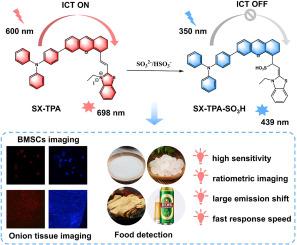具有大发射位移的比例荧光探针,用于检测活细胞、食物和植物中的二氧化硫衍生物。
IF 4.6
2区 化学
Q1 SPECTROSCOPY
Spectrochimica Acta Part A: Molecular and Biomolecular Spectroscopy
Pub Date : 2025-09-27
DOI:10.1016/j.saa.2025.126999
引用次数: 0
摘要
二氧化硫(so2)衍生物在食品添加剂、特定生理环境和植物发育机制中发挥着重要作用,但暴露水平升高会对人类健康和植物活力产生不利影响。因此,SX-TPA比例荧光探针具有灵敏度高(检出限0.201 μM)、选择性好、抗干扰能力强、响应速度快等特点。SX-TPA通过Michael亲核加成特异性地区分so2衍生物。该反应破坏了探针骨架内π共轭,阻断了分子内电荷转移(ICT)过程,从而引起了明显的发射位移(Δλ = 259 nm)。重要的是,SX-TPA即使在复杂的真实食品样品、生物活细胞和植物洋葱表皮组织中也表现出出色的成像和检测能力。本文章由计算机程序翻译,如有差异,请以英文原文为准。

A ratiometric fluorescent probe with a large emission shift for the detection of sulfur dioxide derivatives in live cells, foods and plant
Sulfur dioxide (SO₂) derivatives fulfill essential roles within food additives, specific physiological contexts, and plant development mechanisms, yet heightened exposure levels are associated with adverse effects on human health and plant viability. Thus, the ratiometric fluorescent probe SX-TPA was engineered for detecting SO₂ derivatives, boasting high sensitivity (detection limit: 0.201 μM), excellent selectivity and anti-interference capability, and rapid response. SX-TPA discriminates SO₂ derivatives specifically via Michael nucleophilic addition. This reaction disrupts the π-conjugation within the probe skeleton and blocks the intramolecular charge transfer (ICT) process, thus eliciting a marked emission shift (Δλ = 259 nm). Importantly, the SX-TPA exhibits outstanding imaging and detection capabilities even in complex real food samples, biological living cells, and the epidermal tissue of plant onions.
求助全文
通过发布文献求助,成功后即可免费获取论文全文。
去求助
来源期刊
CiteScore
8.40
自引率
11.40%
发文量
1364
审稿时长
40 days
期刊介绍:
Spectrochimica Acta, Part A: Molecular and Biomolecular Spectroscopy (SAA) is an interdisciplinary journal which spans from basic to applied aspects of optical spectroscopy in chemistry, medicine, biology, and materials science.
The journal publishes original scientific papers that feature high-quality spectroscopic data and analysis. From the broad range of optical spectroscopies, the emphasis is on electronic, vibrational or rotational spectra of molecules, rather than on spectroscopy based on magnetic moments.
Criteria for publication in SAA are novelty, uniqueness, and outstanding quality. Routine applications of spectroscopic techniques and computational methods are not appropriate.
Topics of particular interest of Spectrochimica Acta Part A include, but are not limited to:
Spectroscopy and dynamics of bioanalytical, biomedical, environmental, and atmospheric sciences,
Novel experimental techniques or instrumentation for molecular spectroscopy,
Novel theoretical and computational methods,
Novel applications in photochemistry and photobiology,
Novel interpretational approaches as well as advances in data analysis based on electronic or vibrational spectroscopy.

 求助内容:
求助内容: 应助结果提醒方式:
应助结果提醒方式:


